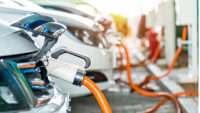A public-private partnership in the San Francisco Bay Area plans to build a $1-billion network of electric-car charging stations, while in Portland, Ore., a utility and two private firms already are erecting electric vehicle battery-charging stations in a cluster of nearby cities.

In Oregon, Nissan Motors and Renault SA have signed a memorandum of understanding with Gov. Ted Kulongoski (D) to supply electric vehicles to the state’s fleet in 2010. Nissan also committed to work with the state, in partnership with utility Portland General Electric, toward the development of an electric-vehicle-charging network to promote the use of zero-emission vehicles.
As part of a pilot program started last summer, PGE already has erected eight stainless-steel plug-in charging stations 7 ft, 8 in. tall, 18 in. wide and 10.5 in. deep within its compact service territory and plans four more stations, says Steve Corson, company spokesman. Each station costs between $3,000 and $10,000, depending on “what it takes to get power out to the chosen location,” he adds. To comply with state mandate, the power will come entirely from renewable sources.
Electric-Vehicle Capital
Palo Alto, Calif.-based Better Place, along with San Francisco Mayor Gavin Newsom (D), San Jose Mayor Chuck Reed (D) and Oakland Mayor Ron Dellums (D), also have announced an electric-vehicle partnership. The mayors agreed on a nine-step plan, including expedited permitting, incentives for employers to install electric-vehicle charging systems in their workplaces and programs for pooled-purchase orders for such vehicles in state-and-local-government and private-sector fleets. “Our goal is to make the Bay Area and eventually California the electric-vehicle capital of the world,” said Newsom.
Network planning and permitting will begin this month, and infrastructure deployment is scheduled to be completed in 2012, following a model proven in Israel, Denmark and Australia.
Better Place reportedly is planning to install a total of 200,000 charging ports and 200 battery-exchange stations in the Bay Area. Better Place officials did not respond to requests for comment. Better Place CEO Shai Agassi claims to have raised $200 million in venture capital since founding the company in 2007. The Better Place model allows for fixed- battery and battery-exchange electric vehicles to operate on its network.
Better Place’s charging spots are about the same size as a parking meter. In fully automated battery-exchange stations, drivers pull up, the depleted battery is removed by robotic arms and a replacement installed within three minutes.
Better Place’s lithium-ion battery can last more than 100 miles and can be recharged at approximately one minute per mile driven.



